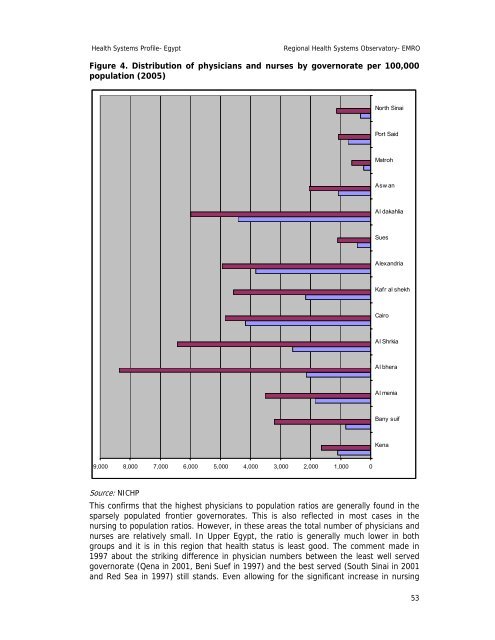Egypt : Complete Profile - What is GIS - World Health Organization
Egypt : Complete Profile - What is GIS - World Health Organization
Egypt : Complete Profile - What is GIS - World Health Organization
Create successful ePaper yourself
Turn your PDF publications into a flip-book with our unique Google optimized e-Paper software.
<strong>Health</strong> Systems <strong>Profile</strong>- <strong>Egypt</strong> Regional <strong>Health</strong> Systems Observatory- EMRO<br />
Figure 4. D<strong>is</strong>tribution of physicians and nurses by governorate per 100,000<br />
population (2005)<br />
9,000<br />
8,000<br />
7,000<br />
6,000<br />
5,000<br />
4,000<br />
3,000<br />
2,000<br />
1,000<br />
0<br />
North Sinai<br />
Port Said<br />
Matroh<br />
Aswan<br />
Al dakahlia<br />
Sues<br />
Alexandria<br />
Kafr al shekh<br />
Cairo<br />
Al Shrkia<br />
Al bhera<br />
Al menia<br />
Bany suif<br />
Source: NICHP<br />
Th<strong>is</strong> confirms that the highest physicians to population ratios are generally found in the<br />
sparsely populated frontier governorates. Th<strong>is</strong> <strong>is</strong> also reflected in most cases in the<br />
nursing to population ratios. However, in these areas the total number of physicians and<br />
nurses are relatively small. In Upper <strong>Egypt</strong>, the ratio <strong>is</strong> generally much lower in both<br />
groups and it <strong>is</strong> in th<strong>is</strong> region that health status <strong>is</strong> least good. The comment made in<br />
1997 about the striking difference in physician numbers between the least well served<br />
governorate (Qena in 2001, Beni Suef in 1997) and the best served (South Sinai in 2001<br />
and Red Sea in 1997) still stands. Even allowing for the significant increase in nursing<br />
Kena<br />
53

















